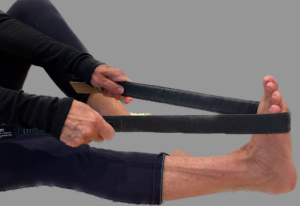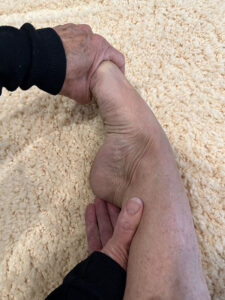Cramping your style?
Like most older folks, I experience lower-leg muscle cramps. They tend to show up in the wee hours of the night, jolting me awake with searing pain. These night-time intrusions (termed nocturnal leg cramps) are pretty common – about 1 in 3 adults, beginning at age 50, regularly experience after-hours calf cramping.
The nocturnal leg cramp goes by many creative monikers: In the U.S. we call it a charley horse or a spasm. To the Brits it’s a chopper; to those in Australia it’s a corky.
Whatever you call it, the nocturnal leg cramp results in continuous, involuntary, painful, and localized contraction of an entire muscle group, an individual muscle, or select muscle fibers within a muscle.
Generally, an idiopathic or benign muscle cramp lasts between a few seconds and a few minutes. Underlying pathologic causes often can be blamed for cramping (see accompanying table). The intensity of feeling ranges from mild twitches to significant discomfort to severe pain. People seeking relief tend to palpate the muscle area of the cramp, which presents as a “muscle knot” that feels like a rock.
| Types of Muscle Cramps | Underlying Pathologic Cause |
| Physiologic | Dehydration, exercise-induced, idiopathic, pregnancy, liver cirrhosis, hypothyroidism, malnutrition |
| Metabolic | Cirrhosis, hypothyroidism, malnutrition, uremia/hemodialysis |
| Medication-induced | Beta-agonists, diuretics, statins |
| Neuromuscular discorders | Amyotrophic lateral sclerosis (ALS), Acquired neuropathy, radiculopathy, metabolic myopathies |
| Other conditions | Parkinson’s disease, dystonia, multiple sclerosis, stroke |
Despite the high prevalence of night-time muscle cramps, researchers don’t fully understand why some people cramp and others do not. Nor is there a reliable method to predict when or where a cramp will occur. In fact, there are not even proven interventions. Leg-cramp management can be a real pain. It’s frustrating and difficult for individuals and their health-care providers.
What are muscle cramps?

Nocturnal muscle cramps characterize electrically by the repetitive firing of a motor unit’s action potential.
Electrically, nocturnal muscle cramps characterize by repetitive firing of a motor unit’s action potential – a muscle’s contraction rate – up to 150 contractions per second. This is more than four times the usual rate in maximum voluntary contraction.
The accompanying image illustrates a typical motor unit configuration consisting of motor neurons (nerves) and the muscle fibers (myofibers) they stimulate. The motor nerve sends signals to muscle fibers along the axon — which is covered by a protective, insulating sheath of myelin — and “instructs” them to act. The nerve signal’s incoming information determines the rate, duration, and strength of muscle action. One can control the signal and resulting contraction during a voluntary muscle movement. But that nerve-muscle contraction also can occur involuntarily, spontaneously, and unfortunately, while you are sleeping.
What to do when you get a cramp
For most people, muscle cramps resolve on their own without medical treatment. Thus, little research has been done to determine the effectiveness of any medication, pill, injection, or home remedy. To date, research shows the majority of muscle-cramp treatments demonstrate low efficacy; their therapeutic action is unreliable or unpredictable.
The easiest treatment for healthy subjects when a cramp presents is to stretch the involved muscle(s), and/or apply deep massage. For most leg cramps, it is safe to get up and walk around. To ease residual pain following cramp resolution, try applying ice (in a plastic bag or towel). Here are some simple leg stretches that have proven helpful in relaxing muscle cramps. Click on each image to enlarge.
Hamstring stretch
 If cramps locate in the back of the thigh — in any part of the three-muscle hamstring group (semitendinosus, semimembranosus, and biceps femoris) — the simplest and quickest stretch is to lie flat on your back with knees bent. Straighten the affected leg by slowly unbending the knee and drawing the leg up toward your chest.
If cramps locate in the back of the thigh — in any part of the three-muscle hamstring group (semitendinosus, semimembranosus, and biceps femoris) — the simplest and quickest stretch is to lie flat on your back with knees bent. Straighten the affected leg by slowly unbending the knee and drawing the leg up toward your chest.
Quadriceps stretch
 When a muscle cramp locates in the front of the thigh in any part of the three-quadriceps muscle group (the rectus femoris, vastus lateralis, vastus medialis, and biceps femoris), the simplest and quickest stretch is to remain in bed. Lie on your side and bend the affected leg at the knee. Grab the foot from behind and pull it back toward the buttocks.
When a muscle cramp locates in the front of the thigh in any part of the three-quadriceps muscle group (the rectus femoris, vastus lateralis, vastus medialis, and biceps femoris), the simplest and quickest stretch is to remain in bed. Lie on your side and bend the affected leg at the knee. Grab the foot from behind and pull it back toward the buttocks.
Calf stretch
 When cramps locate in the calf muscles (gastrocnemius, soleus, and Achilles tendon), standing can help. Or you can lie on your back and place the leg to be stretched straight out in front. Place a towel or belt along the ball of the foot while holding the ends in each hand. Draw the toes and foot up toward the ceiling, and pull through the towel/belt to increase ankle flexion until the muscle relaxes.
When cramps locate in the calf muscles (gastrocnemius, soleus, and Achilles tendon), standing can help. Or you can lie on your back and place the leg to be stretched straight out in front. Place a towel or belt along the ball of the foot while holding the ends in each hand. Draw the toes and foot up toward the ceiling, and pull through the towel/belt to increase ankle flexion until the muscle relaxes.
Foot stretch
 When cramps locate in the foot muscles, simply standing up and putting weight on the affected foot will help. Or, while lying down or sitting, cross the affected foot over the opposite leg, or rest it on the floor/bed. Grasp the middle of the foot so that your thumb is resting along the arch. Slowly pull the foot downward (for plantar flexion). There are 29 muscles that associate with the foot; 10 originate outside the foot but cross the ankle joint to act on the foot, and 19 are intrinsic to the foot itself.
When cramps locate in the foot muscles, simply standing up and putting weight on the affected foot will help. Or, while lying down or sitting, cross the affected foot over the opposite leg, or rest it on the floor/bed. Grasp the middle of the foot so that your thumb is resting along the arch. Slowly pull the foot downward (for plantar flexion). There are 29 muscles that associate with the foot; 10 originate outside the foot but cross the ankle joint to act on the foot, and 19 are intrinsic to the foot itself.
When all else fails, try … pickle juice!
When I was a collegiate basketball player, I occasionally got leg cramps during games. But there were no “approved” treatments, so my teammates and I were left ingesting salt tablets that seldom worked. Our team athletic trainers were firm believers in trial and error, always seeking alternatives as long as there were no deleterious side effects. One intervention that seemed to work for many of the players (but not me), was pickle juice. That’s right, pickle juice!
And surprisingly, some recent research seems to support using sips of pickle brine at cramp onset. It seems pickle juice inhibits cramps through a reflex involving a nerve that originates in the oropharyngeal region (back of the throat) that reduces the firing of alpha motor neurons of the cramping muscle. That’s why a tablespoon of pickle brine hitting the back of the throat seems to bring relief within seconds.
The juice should be strained from jars of dill or kosher pickles, or other acidic substances such as mustard or apple cider vinegar. Several studies report that pickle juice reduces muscle-cramp severity within 35-85 seconds of ingestion, without adverse events.
Researchers in the U-M Medical School’s Division of Gastroenterology and Hepatology have since performed a randomized control study to find that a sip of pickle juice also reduces muscle-cramp intensity in cirrhosis patients.
References
- Blyton, F., et al. “Non-drug therapies for lower limb muscle cramps.” Cochrane Database Syst Rev. 2012. p. CD008496. doi:10.1002/14651858.CD008496.pub2.
- Blyton. F., et al. “Unknotting night-time muscle cramp: A survey of patient experience, help-seeking behavior, and perceived treatment effectiveness.” Journal of Foot and Ankle Research, 2012 Mar 15;5:7.
- Daniell, H.W. “Simple cure for nocturnal leg cramps.” New England Journal of Medicine, 1979;301:216.
- Dijkstra, J.N., et al. “Muscle cramps and contractures: Causes and treatment.” Practical Neurology, 2023 Feb;23(1):23-34.
- Giuriato, G., et al. “Muscle cramps: A comparison of the two leading hypotheses.” Journal of Electromyography & Kinesiology, 2018;41:89–95.
- Hallegraeff, J., et al. “Criteria in diagnosing nocturnal leg cramps: A systematic review,” BMC Family Practice. 2017;18:29.
- Katzberg, H., Khan, A., So, Y. “Assessment: Symptomatic treatment for muscle cramps (an evidence-based review): Report of the Therapeutics and Technology Assessment Subcommittee of the American Academy of Neurology.” Neurology. 2010;74:691–696.
- Miller, K.C., et al. “Reflex inhibition of electrically induced muscle cramps in hypohydrated humans.” Medicine & Science in Sports & Exercise. 2010 May;42(5):953-61.
- Swash, M., et al. “Muscular cramp: causes and management.” The European Journal of Neurology. 2019;26:214–21.
- Tapper, E.B., et al. “Pickle Juice Intervention for Cirrhotic Cramps Reduction: The PICCLES Randomized Controlled Trial.” American Journal of Gastroenterology. 2022 Jun 1;117(6):895-901.
- Weiner, I.H., Weiner, H.L. “Nocturnal leg muscle cramps.” JAMA 1980;244:2332–3.
(Lead image is courtesy of iStock.)






Jef Lopes - 2006
As an OT with experience across practice areas and populations, I appreciated the breadth of perspective and remedial approaches this article articulated. It would also have been instructive to see structural/skeletal and other orthopedic precursors included in the underlying pathologic causes column. Work seating and sleep positioning, especially considering the not insignificant duration of each, have no less a role in providing both preventive and post-insult redress, as well. While the onus of adapting our own behavioral-occupational repertoire, for the sake of increased physiologic harmony, seems to be a cultural priority–and there’re plenty of well justified reasons for this–adding a developmental and ecological perspective on challenges like this may also offer a supplemental array of resources otherwise obscure or invisible to a person or population.
Thank you for your long standing contributions to the field; I always look forward to reading your work, which makes accessible, to readers, a viewpoint and tools to make the changes of the bodies we inhabit appear less daunting and more a part of our broader commonalities opportunities for cooperation.
Reply
Monica Weyhe - 1991 MLIS
I have 2 questions. My parents suffered from severe leg cramps, as do I. I’ve used all the stretches you mention, intuitively to release the pain naturally. My mother always talked about “walking the floor” until the cramps were gone, as you implied especially with foot cramps; and drinking quinine water. My questions: 1) have nocturnal cramps been proven to be hereditary? and 2) does quinine really help, and perhaps in the way of pickle juice?
thanks, Monica
Reply
Vic Katch
Hi Monica. Thanks for your questions regarding your leg cramps. Benign night-time cramps are not genetic, although there is a condition called Familial Spastic Paraplegia which is a rare genetic disease that results in gradual muscle weakness making walking difficult, which I’m sure you do not have. And, regarding quinine; be advised it is no longer recommended because of the possible dangerous side effects. Here is a 2015 research paper titled: Quinine: Not A Safe Drug for Nocturnal Leg Cramps that you may be interested in reading: https://www.ncbi.nlm.nih.gov/pmc/articles/PMC4347765/. Good luck.
Reply